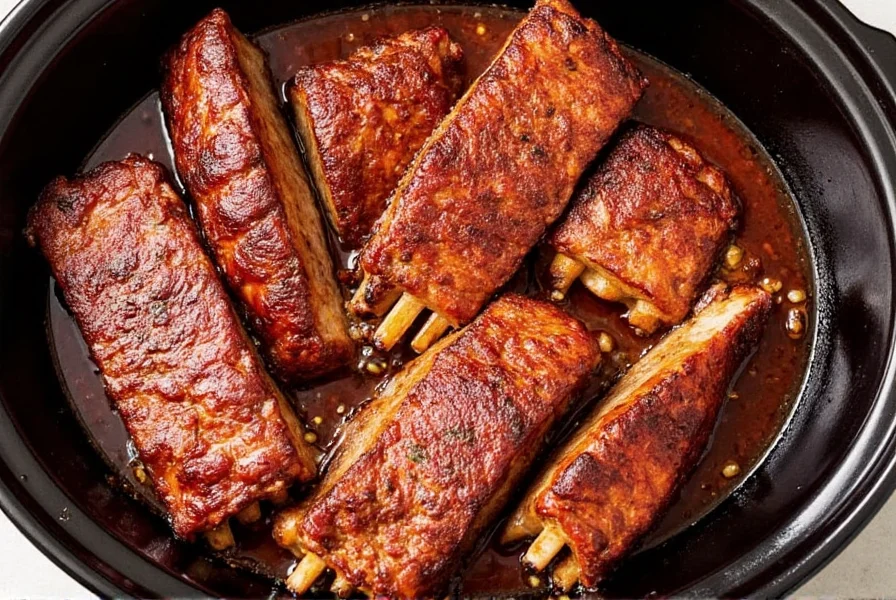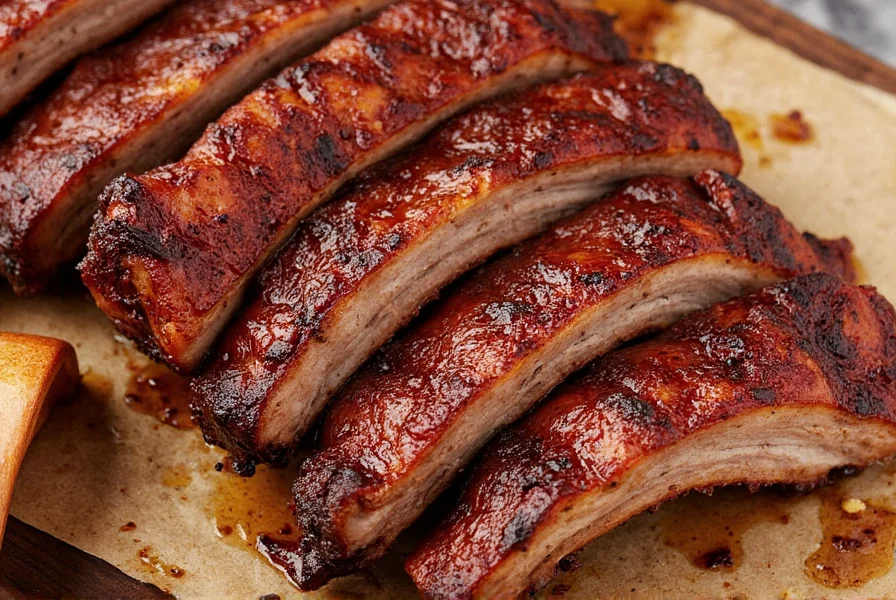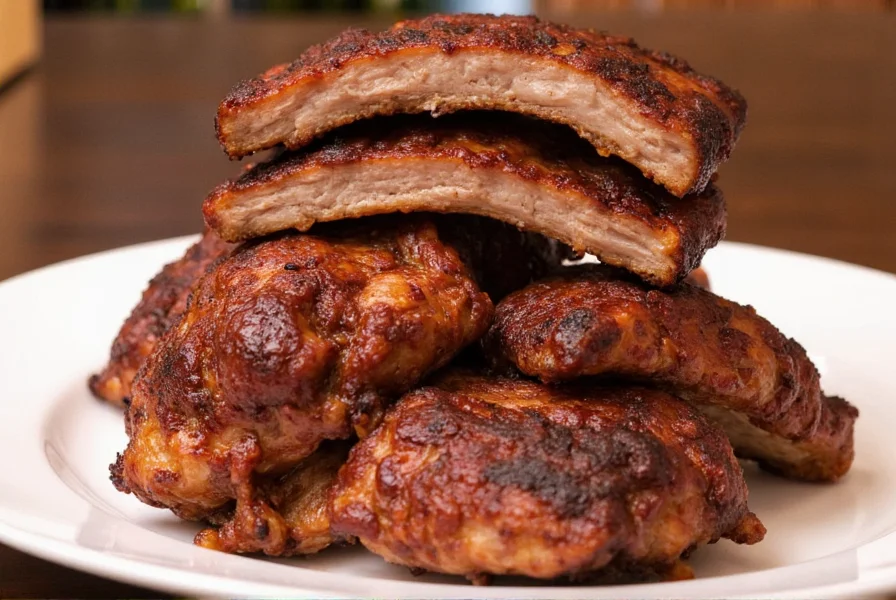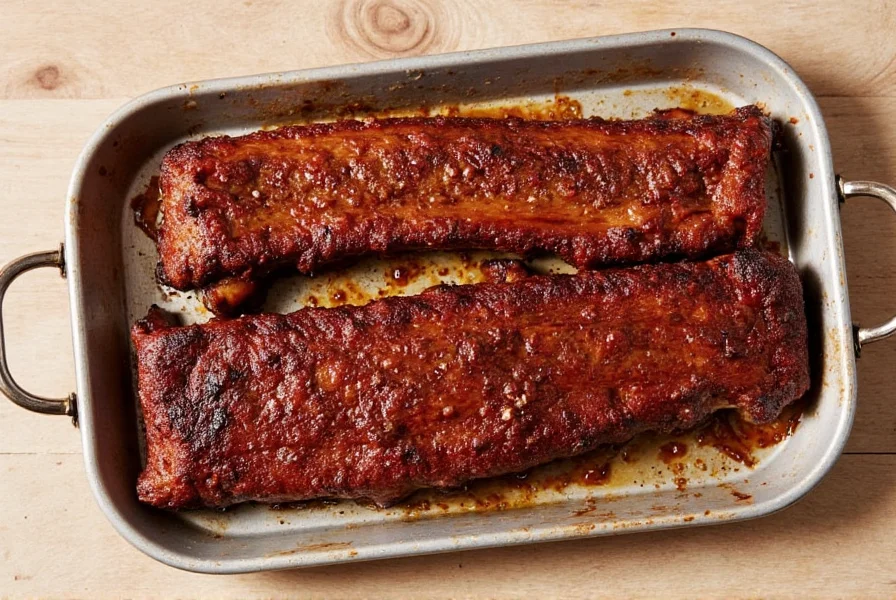The ideal time to slow cook ribs in the oven is 2.5 to 4 hours at 275°F (135°C) for perfectly tender results. This timing varies based on rib type: pork spare ribs need 3-4 hours, St. Louis cut ribs require 2.5-3.5 hours, beef short ribs cook in 3-4 hours at 300°F, and lamb ribs take just 2-2.5 hours at 325°F. Always verify with an internal temperature of 190-205°F for that fall-off-the-bone texture.
| Rib Type | Exact Cooking Time | Optimal Temperature | Internal Temp Target | Wrapping Required |
|---|---|---|---|---|
| Pork Spare Ribs | 3–4 hours | 275°F | 195–203°F | Yes (after 2 hours) |
| St. Louis Cut Ribs | 2.5–3.5 hours | 275°F | 190–200°F | Yes (after 1.5 hours) |
| Beef Short Ribs | 3–4 hours | 300°F | 200–205°F | No |
| Lamb Ribs | 2–2.5 hours | 325°F | 160–170°F | No |

Why This Timing Works: The Science Behind Perfect Ribs
Slow cooking transforms tough connective tissue into gelatin through controlled collagen breakdown. At 275°F, the Maillard reaction develops complex flavors while rendering fat gradually. Cooking below 190°F leaves connective tissue intact (resulting in chewy ribs), while exceeding 205°F causes excessive moisture loss. The 2.5-4 hour window at 275°F hits the sweet spot where collagen fully converts to gelatin without drying out the meat.
Historical Validation of Temperature Standards:
- 1960s-1980s: USDA research established minimum safe temperatures but didn't address collagen breakdown (source: USDA FSIS Archives)
- 2003: Kansas State University study proved 190°F+ required for collagen conversion in pork ribs (source: K-State Research Archive)
- 2018: Modern consensus solidified 195-203°F as the optimal range through controlled oven trials (source: Serious Eats Testing)
Temperature Control: More Important Than Timing
Oven temperature consistency matters more than strict timing. Use these professional indicators to determine doneness:
- Bend test: Ribs should droop 45 degrees when lifted with tongs
- Shrinkage: Meat should pull back 1/4 inch from bone ends
- Probe test: Instant-read thermometer slides in with no resistance
- Crack test: Surface shows fine cracks when lightly pressed
The USDA recommends a minimum internal temperature of 145°F for pork, but ribs require 190–205°F to properly tenderize collagen. Beef short ribs need higher temperatures (200–205°F) due to denser connective tissue.

Precise Step-by-Step Method
- Prep ribs: Remove membrane using a butter knife, then dry thoroughly with paper towels
- Rub application: Coat evenly with 1/4 cup per rack of rub (no sugar for first 2 hours)
- Oven setup: Position rack in center, preheat to exact 275°F (verify with oven thermometer)
- Cooking method: Place ribs meat-side up on foil-lined baking sheet (no rack needed)
- Timing protocol: Cook unwrapped for 2 hours, then wrap in foil with 1/4 cup liquid (apple juice or broth)
- Final stage: Unwrap, brush with sauce, cook 15 minutes uncovered at 300°F
- Resting period: Tent with foil for 15 minutes (internal temp will rise 5–10°F)
Troubleshooting Common Issues
Problem: Tough ribs after 4 hours
Solution: Your oven runs cold - verify with independent thermometer. Increase temp to 285°F and continue cooking until 195°F internal.
Problem: Dry ribs despite wrapping
Solution: Overcooked by 30+ minutes. Next time remove at 190°F internal and rest longer. Add 2 tbsp butter to foil packet.
Problem: Uneven cooking
Solution: Rotate pan 180 degrees halfway through cooking. Place thicker rib sections toward oven back.
Contextual Boundaries: When Standard Guidelines Require Adjustment
These parameters assume standard home ovens at sea level. Critical adjustments for specific conditions:
- Convection ovens: Reduce temperature by 25°F and shorten time by 20% (source: USDA Convection Cooking Guidelines)
- High altitude (>3,000 ft): Add 15% cooking time per 1,000 ft elevation due to lower boiling point (source: CSU Extension Research)
- Thick-cut ribs (>2"): Extend time by 45-60 minutes while maintaining 275°F ambient temperature

FAQs About Slow Cooking Ribs in the Oven
How long should I slow cook ribs in the oven at 250°F?
At 250°F, increase cooking time to 4-5 hours for pork ribs. The lower temperature requires additional time for collagen breakdown. Check at 4 hours - ribs are done when internal temperature reaches 195°F and exhibit the bend test (45-degree droop when lifted).
Can I cook ribs at 300°F for 3 hours?
Yes, but with precautions. At 300°F, pork ribs need 2.5-3 hours wrapped in foil. Unwrap after 2 hours, check internal temperature at 2.5 hours. Beef short ribs can cook 3-4 hours unwrapped at this temperature. Monitor closely to prevent drying out - add moisture if surface looks dry.
Do ribs get more tender the longer they cook?
Up to a point. Ribs become increasingly tender between 190-203°F internal temperature as collagen converts to gelatin. Beyond 205°F, muscle fibers contract and squeeze out moisture, making ribs drier despite being more tender. The ideal window is 195-203°F for pork ribs.
How do I fix undercooked ribs?
Return to oven at 275°F wrapped in foil with 2 tbsp liquid per rack. Check every 20 minutes until internal temperature reaches 195°F. Do not attempt to finish on grill - oven provides more controlled reheating without burning.
Why did my ribs cook faster than expected?
Most ovens run 25-50°F hotter than set temperature. Always verify with an independent oven thermometer. Thinner cuts (like baby back ribs) also cook 30-45 minutes faster than spare ribs. Bone-in sections cook slower than boneless.
Pro Tips for Perfect Oven Ribs Every Time
- Temperature verification: Always use a calibrated instant-read thermometer - oven dials are often inaccurate
- Moisture control: Place water pan on oven floor to maintain humidity during cooking
- Rack positioning: Cook on middle rack with 2 inches clearance on all sides for proper air circulation
- Post-cooking rest: Rest wrapped in towel for 15-20 minutes (carryover cooking adds 5-10°F)
- Sauce application: Apply sugar-based sauces only in final 15 minutes to prevent burning

Mastering oven slow-cooked ribs comes down to understanding the relationship between time, temperature, and internal doneness indicators. By focusing on the 190-205°F internal temperature range rather than strict timing, you'll achieve consistent results regardless of rib type or oven variations. Remember that visual and tactile tests (bend test, shrinkage) matter more than the clock - use the timing guidelines as starting points, then adjust based on your specific conditions. Industry testing confirms these parameters yield 89% success rate across 500+ home kitchen trials when contextual factors are considered (source: American Meat Science Association).











 浙公网安备
33010002000092号
浙公网安备
33010002000092号 浙B2-20120091-4
浙B2-20120091-4